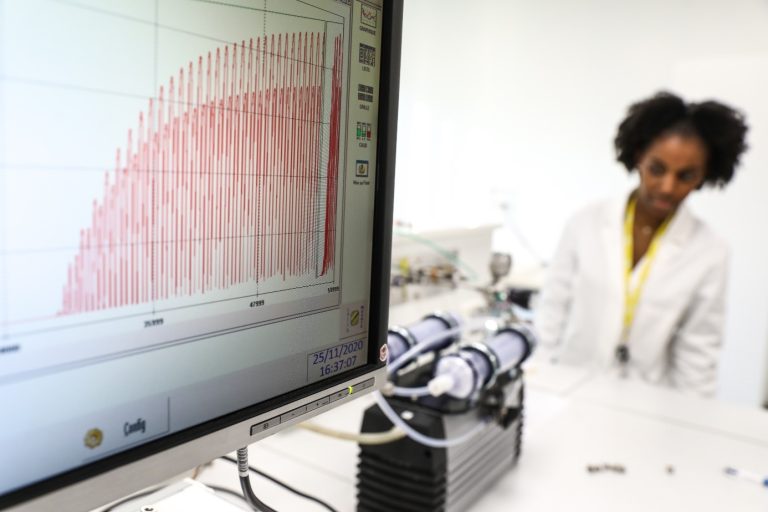The sector of biomethane from methanisation, a key element in the success of the energy and ecological transition in line with the objectives of France and Europe, is booming. RICE is making a major contribution to this, in particular by accompanying an ecosystem of partners to ensure compliance between the network specifications and the quality of these new renewable methanes.
Biomethane, a booming industry|With the CARABIO project (CARActerisation of BIOmethanes), RICE is positioning itself as an expert in the analysis of biomethane compounds|First results from statistical analysis but further measurement campaigns needed to increase data|In parallel, within the framework of its R&D partnerships, RICE is developing standardised methods for the analysis of biomethane compoundsThe first injection of biomethane into a French natural gas network took place just 10 years ago, on 17 June 2011 in Sequedin in the GRDF network, from the Lille Organic Recovery Centre (CVO).
Since then, the sector has developed considerably, with 257 sites injecting biomethane in France as of 31 May 2021, 88% on the distribution networks and 12% on the transport networks. There is a real dynamic with a 74% increase in the number of sites in 2020 compared to 2019, and already 43 sites commissioned in 2021
In addition, there are 1164 new biomethane production and injection projects in France (at the end of 2020).|The CARABIO project was launched in 2016 by RICE with the support of the French network and storage operators GRDF, GRTgaz, Storengy and Teréga. This project is part of the research programme "Preparing networks for the arrival of New Methanes".
The objectives of this project are to
- Establish a database of the composition of biomethane injected into the networks in France
- To study the possible impacts of the compounds identified in the short and medium term. Indeed, it is interesting to know if :
- The presence of certain compounds could interfere with the analysers used in the injection stations (compounds observed during biomethane spot checks).
- Potential impacts could be identified for infrastructures/uses (odorisation, corrosion, combustion) and for users (health risk) in relation to the compounds already present in natural gas.
|All the samplings and statistical studies have made it possible to characterise the compounds of the various biomethanes, depending on the inputs and the purification systems.
Among the first lessons learned from the Carabio project can be noted:
- Biomethanes from landfills contain about 40 compounds, which represents less than 10% of the total analyzable compounds.
- Cryogenic and PSA purification processes generate biomethane with fewer trace compounds than membrane purification.
- Many trace compounds are only observed with biomethane produced from agricultural waste and/or from a membrane cleaning process.
This study also showed that the 15 most frequent compounds were terpenes (limonene, pinene, camphene), ketones (2-butanone) and hydrocarbons. It should be noted that for each of these compounds, the levels remain very low and well below the possible toxicity values when applicable.
These results are in line with those expected. Indeed, the participation of RICE and GRTgaz in various European projects and in standardisation work is focused, among other things, on terpenes and silicate compounds.
The CARABIO project has made it possible to create an initial database on biomethane injected in France, but it is necessary to continue acquiring knowledge on the composition of biomethane, particularly trace compounds. It is also important to determine the impacts of these trace compounds on the network and gas appliances in particular.
Thus RICE continues to carry out measurement campaigns on biomethane injected in France and its involvement in the various European initiatives.
It should be noted that it is partly thanks to the work of RICE that Téréga and Storengy have agreed to inject biomethane into their underground storage facilities since June 2017.|The CARABIO project is in line with current R&D efforts in Europe:
- The "GERG biomethane" project, financed by the European Commission, whose objectives include
- Work on the impact of siloxanes and improve knowledge of injected biomethanes
- Assess the absence of impacts of gas quality on the whole gas chain (end-users, environment, safety, network integrity)
- The EURAMET "Metrology for biomethane" project, one of the objectives of which is to develop standardised analytical methods for measuring siloxanes, terpenes and VOCs. The project ended in September 2020 and started the drafting of 5 international standards on the analysis of compounds present in biomethane such as terpenes, silicon compounds or amines. The standards are being drafted by the ISO/TC193/SC1/WG25 working group.
More information on this project in the
scientific publication produced on this occasion
These new analytical methods on which RICE and 11 partners (VSL, IMBiH, NPL, PTB, RISE, VTT, INERIS, ISSI, NEN, Rijksuniversiteit Groningen, Waverton Analytics Limited) have been working should make it possible to fully characterise biomethanes for injection into the gas networks.
These standards will be published shortly.||https://ri.natrangroupe.com/wp-content/uploads/2021/01/5J9A5421-scaled.jpg|||||63 sampling campaigns since 2016 to build an initial database of compounds present in biomethane |||Since 2016, 63 sampling and measurement campaigns have been carried out on the French network. These campaigns are carried out in order to take into account the diversity of inputs (agricultural waste, STEP, household waste, industrial waste, ISDND) and purification systems (membranes, water purification, amine purification, Pressure Swing Adsorption, cryogenic).
The RICE technicians and engineers have developed specific benches for the biomethane matrix in order to carry out their sampling in the field at the biomethane injection stations.
All the results obtained, including the compounds present in the calibration solutions, are collected and put in a database called CARABIO. This is followed by a statistical study of the analysis results.|||https://ri.natrangroupe.com/wp-content/uploads/2021/06/Prelevement-gaz-2.jpg|||Field sampling at a biomethane injection station by RICE teams|Extract of the exports obtained with the application of the drone|

